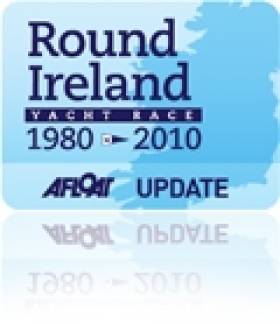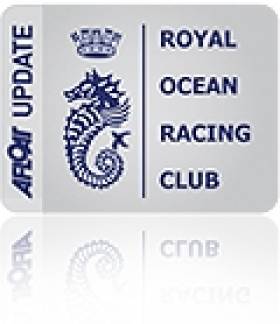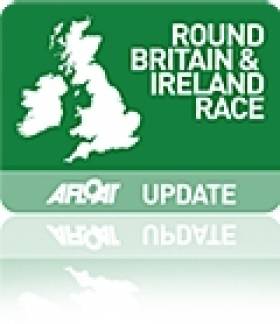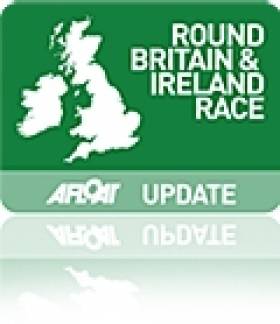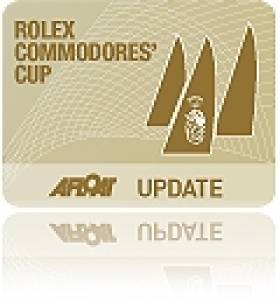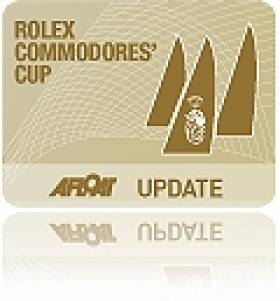Displaying items by tag: RORC
Round Ireland Remembered: Saturday Night is Vroon Night
Round Ireland Champ Piet Vroon from Holland is in Wicklow town for Saturday night's celebration of the 30th Round Ireland. Vroon, 80, who has already picked up the Royal Ocean Racing Club's Yacht of the Year award is back in Wicklow and it is certain exploits during Ireland's offshore race in July will be relived when Vroon lifts the Round Ireland trophy at the Park Hotel in Newtownmountkennedy. The Wicklow Sailing Club prize giving includes a new Irish Cruiser Racing Association trophy (ICRA) and the inaugural winner is a local boat, Aquelina (The Tyrrell fmaily) from Arklow.
Among the attendance at the offshore night of the year is 19 crew from visiting UK competitor Malta Puma.
More on the Round Ireland Yacht Race:
Round Ireland Yacht Race 2010 Review
Round Ireland Yacht Race, Ireland's top offshore fixture
A Round up of 80 stories on the 2010 Round Ireland Yacht Race
Round Ireland Winner is RORC's Yacht of the Year
The Royal Ocean Racing Club in London announced that Holland's Piet Vroon's Ker 46 Tonnerre de Breskens 3 is the 2010 Yacht of the Year.
Piet has been racing with the RORC for 50 years and during that time has achieved many notable successes including winning the Rolex Fastnet Race. Now 80 years young, he competed in eight RORC races this season including the Conway Media Wicklow's Round Ireland and the Sevenstar Round Britain and Ireland Race.
Tonnerre de Breskens 3 takes the Jazz Trophy for the overall winner of the Season's Points Championship (when all races count); the Trenchemer Cup for winning IRC Zero; the Stradivarius Trophy for the best overseas yacht in IRC and also the Somerset Memorial Trophy for outstanding racing achievement by a yacht owned or sailed by a RORC member as voted for by the Main Committee. It was a spectacular season from a veteran campaigner and great supporter of RORC racing.
Niklas Zenstrom's JV72, Rán 2, was awarded the Dennis P Miller Memorial Trophy for a British Yacht Overseas. Rán travelled all over the world and has an impressive list of victories which included the Mini-Maxi Rolex World Championships, winning her divisions in the 2009 Rolex Sydney Hobart Race; Antigua Sailing Week; Newport Bermuda Race; Onion Patch Series and Copa del Rey.
Also of note are the team on British Soldier who were second overall in the Season's Points Championships and won the Serendip Trophy for the best series produced yacht in IRC. The boat provides much needed 'R and R' for war veterans and through the Toe in the Water tri-services initiative, introduces many disabled servicemen to sailing.
A full list of all the RORC trophy and award winners:
RORC Annual Challenge Trophies and Special Awards
2010 YACHT OF THE YEAR - TONNERRE DE BRESKENS 3 (KER 46) PIET VROON
Winning the SOMERSET MEMORIAL TROPHY
For outstanding racing achievement by a yacht owned or sailed by a RORC member as voted for by the Main Committee.
In recognition of not only winning IRC Overall by a huge margin, but in particular for supporting and winning RORC races for over 50 years.
ASSUAGE TROPHY - FOGGY DEW (JPK 10.10) NOEL RACINE
CHAMPIONSHIP FOR RORC MEMBERS
For the yacht with the most points in IRC overall in the Cherbourg Race plus her best three races taken from Cervantes, Morgan Cup, Myth of Malham and Cowes-Dinard-St. Malo races
ALAN PAUL TROPHY - BRITISH SOLDIER (A 40) ARMY SAILING ASSOCIATION, LT COL TIM HILL
For consistent high performance in IRC. Based on consistent high scores plus a bonus for number of races completed.
Class Championship Tropies
| IRC Overall | Jazz Trophy | Tonnerre de Breskens 3 (Ker 46) | Piet Vroon |
|---|---|---|---|
| IRC Super Zero | Europeans Trophy | John Merricks II (TP 52) | British Keelboat Academy |
| IRC Zero | Trenchemer Cup | Tonnerre de Breskens 3 (Ker 46) | Piet Vroon |
| IRC One | Emily Verger Plate | Visit Malta Puma (Reflex 38) | Sailing Logic, Philippe Falle |
| IRC Two | Grenade Goblet | Foggy Dew (JPK 10.10) | Noel Racine |
| IRC Three | Cowland Trophy | Iromiguy (Nicholson 33) | Jean Yves Chateau |
| Two-Handed Division | Psipsina Trophy | Psipsina (HOD 35) | John Loden & Patrick Cronin |
| David Fayle Memorial Cup | For the best Sailing School Yacht in IRC | Visit Malta Puma (Reflex 38) | Sailing Logic, Philippe Falle |
|---|---|---|---|
| Haylock Cup | For the best British Service Yacht in IRC | British Soldier (A40) | Army Sailing Association, Lt Col Tim Hill |
| Stradivarius Trophy | For the best Overseas Yacht in IRC | Tonnerre de Breskens 3 (Ker 46) | Piet Vroon |
| Serendip Trophy | For the best Series-produced Yacht in IRC | British Soldier (A40) | Army Sailing Association, Lt Col Tim Hill |
Special Awards
| Freddie Morgan Cup | For a Classic Yacht in IRC | Winsome (S&S 41) | Harry Heijst |
|---|---|---|---|
| Dennis P Miller Memorial Trophy | For a British Yacht Overseas | Rán 2 (JV 72) | Niklas Zennström |
| Arambalza Swan Cup | For the highest scoring Swan in the race season | Selene (Swan 44) | Adrian Lower |
| Peter Harrison Youth Trophy | John Merricks II (TP 52) | British Keelboat Academy | |
| Duncan Munro-Kerr Youth Challenge Trophy | For the youngest crew member on board a yacht which on Season's Points finishes in the top three of her IRC Class |
Floris R. W. Oud sailing on Winsome | |
| Red Funnel Prix D'Elegance | Antix (Ker 39) | Anthony O'Leary | |
| RORC Salver | Morgan Cup Race - First Yacht Home | Tonnerre de Breskens 3 (Ker 46) | Piet Vroon |
2010 RORC Points Championship
RORC Medallions: Gold – 1st, Silver – 2nd, Bronze – 3rd, 4th & 5th
| IRC Super Zero | ||
|---|---|---|
| 1st | John Merricks II (TP 52) | British Keelboat Academy |
| IRC Zero | ||
| 1st | Tonnerre de Breskens 3 (Ker 46) | Piet Vroon |
| 2nd | John B (Grand Soleil 54) | Charles Ivill |
| 3rd | Erivale III (Ker 39) | Mike Greville |
| IRC One | ||
| 1st | Visit Malta Puma (Reflex 38) | Sailing Logic, Philippe Falle |
| 2nd | British Soldier (A 40) | Army Sailing Association, Lt Col Tim Hill |
| 3rd | Coup de Coeur (First 40) | Marc de Saint Denis & Géry Trentesaux |
| IRC Two | ||
| 1st | Foggy Dew (JPK 10.10) | Noel Racine |
| 2nd | Psipsina (HOD 35) | John Loden & Patrick Cronin |
| 3rd | Winsome (S&S 41) | Harry Heijst |
| IRC Three | ||
| 1st | Iromiguy (Nicholson 33) | Jean Yves Chateau |
| 2nd | Ultreia! (JPK 9.60) | Matthias Kracht |
| 3rd | Pyxis (X 332) | Kirsteen Donaldson & Judith Eastwood |
| Two-Handed Division | ||
| 1st | Psipsina (HOD 35) | John Loden & Patrick Cronin |
| 2nd | Solan Goose of Hamble (A 35) | Peter Olden |
| 3rd | Diablo-J (J 105) | Nick Martin |
| Class 40 Division | ||
| 1st | Concise 2 | Ned Collier Wakefield |
| 2nd | Orca | Tom Hayhoe & Natalie Jobling |
| 3rd | Merena | Alexis Guillaume |
| IRC Overall |
||
|---|---|---|
| 1st | Tonnerre de Breskens 3 (Ker 46) | Piet Vroon |
| 2nd | British Soldier (A 40) | Army Sailing Association, Lt Col Tim Hill |
| 3rd | Visit Malta Puma (Reflex 38) | Sailing Logic, Philippe Falle |
| 4th | Psipsina (HOD 35) | John Loden & Patrick Cronin |
| 5th | John Merricks II (TP 52) | British Keelboat Academy |
| Assuage Tankards |
||
|---|---|---|
| Cervantes Trophy Race | Visit Malta Puma (Reflex 38) | Sailing Logic, Philippe Falle |
| Myth of Malham Race | Tonnerre de Breskens 3 (Ker 46) | Piet Vroon |
| Morgan Cup Race | Psipsina (HOD 35) | John Loden & Patrick Cronin |
| Cowes-Dinard-St. Malo Race | John Merricks II (TP 52) | British Keelboat Academy |
RORC Success for Hurley and Martin in Cherbourg
Nick Martin and Cobh's Barry Hurley co-skippered "Diablo-J", a J-105, to not only win the RORC trophy for the Two–Handed Division, but took home the Yacht Club de France trophy for IRC 2 and the Cherbourg trophy for IRC Overall too.
The race started on a perfect sunny early September evening. With the tide and wind behind them, the fleet of 53 yachts set off towards the Needles under spinnaker. However, it wasn't long before wind holes began to appear, particularly off Yarmouth, and the leg out of the Solent became tricky; it turned out to be the hardest part of the race.
Once in the Channel it was a close reach on port all the way to Cherbourg. It was too close for spinnakers but a fast leg nonetheless. As usual the wind went light off Cherbourg so it was vital to be up-tide of the harbour entrance.
First to finish was the Farr 52 Bob at 03 09 56 with an elapsed time of just under 8 hours; indeed it was a quick race for the whole fleet and the last boat finished at 09 41 37. Bob took the Quailo Cup – the trophy for IRC Zero and Super Zero combined. Mike Greville won IRC Zero in his Ker 39 Erivale III. IRC 1 went to Marc de St Denis and Géry Trentesaux in their First 40 Coup de Coeur. IRC 3 was won by Renaud Courbon in the JPK 9.60 Ultreia!
Interviewed after the race, Nick Martin and Barry Hurley talked about their winning strategy: "The race was won and lost on the start line. We realised that the Solent part of the course was going to be make or break before the drag race across the Channel.
We chose to start at the leeward (ODM) end of the line. This gave us clear wind and a good hot wind angle down the Solent. We were very aware of the holes on the island shore. We knew we were not necessarily in the best of tides, but decided that the wind strategy was more important. We were also in good company with Bob and Psipsina."
"The majority of boats were drifting through tide holes, but we stayed on the same gybe with a good angle, all the way down to the Needles. The other boats got sucked into the island side and we avoided it. We had holes, too, but got through Hurst beautifully in second place behind Bob. The fleet were destroying each other, pushing one another up into more tide. Venomous and Psipsina came through on the inside of the Needles, caught a bit of wind and caught us up. When we all caught the same wind, we were off. The four of us were probably 20 minutes ahead of the rest of the fleet at the Needles."

All that was left was the quick trip across the Channel – drop the kite, and up with the big No.2 jib. The only thing interesting about that long leg was that our original heading brought us right in to Cherbourg with a single 4 degree variation one mile out. We pre-judged the heading for the tide 6-7 hours ahead and were heading lower than most of the fleet, who had to try to come down much later. We had 15 – 20 knots with a true wind angle of 50-70 degrees."
"For us the wind only dropped slightly down to maybe 15 knots as we approached Cherbourg, but we got in before it really dropped off at sunrise. It was a brilliant race, really good, and we are delighted with the result. We thought we had the Two – Handed sewn up, we suspected that we had the class result, but to get the overall win was great." Nick Martin was delighted to win his first major RORC overall trophy. "It underpins my belief that the RORC produces and supports great races and provides a fantastic opportunity for two-handed racing."
Most of the Fleet Expected Back by Sunday
It has been over 24 hours since any yacht, competing in the Sevenstar Round Britain and Ireland Race finished writes Louay Habib. However a rush is expected for the second half of the day, with three boats expected in the early hours of tomorrow morning and the majority accounted for by Sunday.
There are still 12 yachts racing in the Sevenstar Round Britain and Ireland Race but Keith Gibbs C&C 115, Change of Course pulled into Dingle on the west coast of Ireland in the early hours of this morning with a broken forestay.
The next boat to finish should be Chaz Ivill's Grand Soleil 54, John B who is expected to finish in the early hours of tomorrow morning and claim third place in IRC Zero. Clipper 68, Hull & Humber look to be getting the better of their sistership, Edinburgh Inspiring Capital. At 1400 BST Hull & Humber had 108 miles to go and were averaging eight knots giving them an estimated finish time of 0400 tomorrow.
At 1400 BST, the Army Association's A 40, British Soldier was passed the Lizard with 195 miles to go. Over the last 24 hours, they have stretched out their lead on the water and look likely to take line honours for Class IRC One. Steven Anderson's First 40.7, Encore is 21 miles behind British Soldier but still leads the class after corrected time.
In IRC Two, Harry Heijst owner of S&S 41 Winsome, had a proper birthday celebration on board. With balloons and the satisfaction of opening up a big lead on rivals, Swan 44 Selene, owned by Adrian Lower. At 1400 BST, Winsome is 28 miles ahead of Selene and even further ahead after corrected time. Selene took up a very westerly position yesterday but the move has not paid off. Winsome with Sevenstar's Managing Director, Richard Klabbers on board, is very much the yacht to beat in IRC Two.
Heading Home in Round Britain and Ireland Race
By sunset tonight all of the competitors racing in the Sevenstar Round Britain and Ireland Race will have rounded Muckle Flugga. For many of them it has been a long hard slog up the North Sea writes Louay Habib.
The leaders are literally at the other end of the course. At 1200 BST, Volvo Open 70, Groupama is just 65 miles from the Scilly Isles. They have chosen a course north of the rhumb line, presumably to take advantage of any new breeze that may emanate from the Bristol Channel. Teléfonica has gybed south and it is anticipated that Groupama will cover them. Groupama have 290 miles to go to the finish of the Sevenstar Round Britain and Ireland Race; Teléfonica are 20 miles behind. Both are expected to finish in Cowes by Sunday afternoon. Obviously this estimated time of arrival will be dependent on the wind strength.
The overall lead under IRC has changed yet again, Piet Vroon's Ker 46, Tonnerre de Breskens is back in the lead. The Dutch yacht is blasting down the west coast of Ireland trying to hang on to the coat-tails of the British Keelboat Academy's TP52, John Merricks II. Before the start of this epic race, the young team were desperately short of funds and up until the last minute, they did not know if they could afford to enter. None of the crew is paid to race, but maintaining and provisioning a TP52 is an expensive business; feeding 18 people for over a week is a huge amount of food. Before the start, they got a helping hand: "This is a tough race and when we heard that the young talented sailors on John Merricks II needed a hand, we were delighted to help," commented ICAP Leopard's Boat Captain, Chris Sherlock. "Racing a TP52 1800 miles takes some doing, but they won't be going hungry. John Merricks are really tight on budget, so with the compliments of ICAP Leopard, they have enough freeze-dried meals to get them around the gruelling course. Best of luck to them."
Doug Innes' First 40.7, Cheeki Rafiki rounded Muckle Flugga in the early hours of the morning. Crewman Ken Allison sums up what it was like to be so far north: "The coldest night so far, up the northwest coast of Shetland, round to Muggle Flugga (isn't that a name you want to spell badly). The phones and internet all sprang into life as we got close to Shetland and civilisation. This gave our first glimpse at how the race has been going for three days. It's great to receive emails and texts from friends and loved ones, wishing us well and offering advice. Plan A seems to be: try to break things less often, trim things more often and keep pushing south. That works for me."
High pressure is working its way across the racecourse from the southwest, giving the fleet far more pleasant conditions. However, for the competitors approaching the west coast of Ireland, there is still a decent moderate breeze from the northwest, pushing them on to finish this challenging race.
Groupama Sets Pace Round Britain and Ireland
Almost exactly two days into the Sevenstar Round Britain and Ireland Race, Franck Cammas' Volvo Open 70, Groupama, was the first yacht to round Muckle Flugga at 1400 BST. They are now heading southwest at a speed of over 17 knots with their 19-mile lead rapidly increasing over their rivals Telefonica Azul, who are still beating up to Muckle Flugga reports Louay Habib.
Jonny Malbon's IMOCA 60, Artemis Ocean Racing, has 77 miles to go to reach the top of the course and will round the remote island alone, as they have been for much of this race. On board is Olympic 49er medallist, Simon Hiscocks who is very much at home racing a 49er or an extreme 40, but offshore racing is a very new concept to him. (See Simon's video blog http://sevenstar.rorc.org/newsblogsphotos.html
Artemis Ocean Racing is going well and 48 hours into the race they are second overall under IRC behind Piet Vroon's Ker 46, Tonnerre de Breskens. Early leaders on handicap, the British Keelboat Academy's TP52, John Merricks II, are now third overall but sailing further offshore and look to be getting into more breeze.
Meanwhile the young crew on Tony Lawson's Class 40, Concise are feeling the effects of this brutal race. "We are cold, wet and busting a gut to keep up with the bigger boats in front of us." Said Tom Gall, skipper of Concise. "The boat has been like a submarine since we left Cowes and we are living off tea and porridge. Tom Dawson comes from Newcastle, and when we passed his home town, he told us how good the fish and chips are. I must say I was licking my lips when I told him to belt-up. This is a tough, tough race but when I look at the crew around me, I just well up with pride for what we are doing."
In IRC Two, Adrian Lower's Swan 44, Selene, is top of the class and has opened up a nine-mile lead on Harry Heijst's S&S 41, Winsome. This may be down to their secret weapon, Tabasco: "We have more bottles of the pepper sauce on board than we have crew," admitted Adrian. "It helps spice up the bland food and warms up the lads as we go north. We are taking part in this race, partly for the challenge of sailing round our Island non-stop, but also to show that an old boat can be competitive."
Driving rain is sweeping across the racecourse but the good news is that the severe weather predicted for Thursday may well be further south than expected. Lighter conditions may well prevail tonight, but one thing that is certain about the Sevenstar Round Britain and Ireland Race; nothing can be taken for granted.
ENDS/...
The Sevenstar Round Britain and Ireland Race is being tracked with OCTrackers. Each boat is supplied with an OCTracker beacon, a self contained unit that transmits the position of the boat at regular intervals using GPS. You can watch the race as it unfolds by visiting: http://sevenstar.rorc.org/tracking.html
22,000 people are also playing the virtual race game. It's not too late to join the race. Sign up via the website: (http://sevenstar.rorc.org/).
Update: Ireland Going Well In Round the Island Race
Ireland is off to a great start this morning in the Round the Island Race. ICRA Commodore Barry Rose is out by the Needles. He says: "Antix is doing super in Class 1. Mariners is fourth on the water and ahead of most her Class One. Roxy second to Rockall, probably third in class" More as we have it.
keep up to date here:
http://commodorescup.rorc.org/fleet-tracking/2010-live-offshore-tracking.html
Send good luck messages here:
http://www.afloat.ie/commodores-cup/item/13716-commodores-cup-send-your-good-luck-wishes-here/
Ireland Continue to Lead Commodores' Cup
Two race wins and a third place for the Irish Cruiser Racing Association (ICRA) team at Cowes have extended Ireland's lead by ten points overnight as the event reaches its penultimate phase tomorrow with the Round Isle of Wight Race. Strong winds gusting to 25 konts are forecast and the team is focussed on avoiding damage.
Ireland has a 40.5 point lead over second placed Hong Kong and 49 points over third-placed France Blue.
Team Captain Anthony O'Leary on Antix won Class 1, continuing his consistent form of race wins and second places this week. Roxy 6 skippered by Andrew Creighton benefitted from an apparent navigational error by Hong Kong's Rockall III that was leading comfortably in Class 3 until a course change was missed and the Irish team boat won the race. Dave Dwyer's marinerscove.ie placed third in Class 2 in a race dominated by British boats La Reponse and Quokka 8.
"We have a very workman like approach to prepararing thoroughly for the 50-miler tomorrow," commented Barry Rose, Commodore of ICRA. "The course has lots of complicated corners and we expect it to be breezy. Its a big challenge that we're taking day by day; our plan goes on as it has from the beginning, concentrating on every detail to be as prepared as we can."
The race around the island counts for 1.5x bonus factor and will be especially tough in the forecast conditions. "The race around the Isle of Wight is going to be pretty long and pretty tough for the small boats," Maurice O'Connell, mainsheet trimmer on Roxy 6. "We're just going to keep doing what we're doing and hope that it all comes good."
A grim overcast start and lumpy wind against tide conditions gave way to brilliant sunshine and a summery finish off the Royal Yacht Squadron for the Rolex Trophy Day inshore race at the 2010 Rolex Commodores' Cup. Today's one race was held around multiple marks in the central western Solent starting in 18 knot southwesterlies with a wet beat through short chop before the tide turned and the wind dropped gradually through the race, ending at below 10 knots .
It was another solid day for the Irish team, leaders since the opening day of the regatta last Sunday. Their big boat, Anthony O'Leary's Ker 39 Antix and their small boat, Robert Davies' Corby 36 Roxy 6 both won their classes today while David Dwyer's marinerscove.ie posted a third. No other team was close to being as consistent today.
In the small boat class Roxy 6 came out on top partly thanks to a navigation error on the Hong Kong boat, Christopher Opielok's Corby 36 Rockall III [at the time of going to press this was subject to a protest for redress]. "We were very lucky," said Roxy 6's helmsman Andrew Creighton. "Rockall went to a wrong mark and they were ahead of us. With them making that mistake it obviously pushed us into first, although one of the French guys, Goa, came very close to us, but we had them by about 25 seconds."
Roxy 6 was only launched in April, but has had an intensive season at regattas throughout the UK and her native Ireland. Designed by Cowes resident John Corby, the 36 footer relished today's conditions. "The short Solent slap suits this sort of boat," said Creighton.
Back at Cowes Yacht Haven, Commodore of the Royal Ocean Racing Club, Andrew McIrvine stepped off the boat he co-owns with Peter Morton in buoyant mood. His Beneteau First 40.7 La Réponse won the mid-sized class today by two and a half minutes on corrected time ahead of past RORC Commodore Peter Rutter's Quokka 8.
"We just went fast," said McIrvine explaining today's result. "Upwind we go higher and faster than we ought to for this size of boat if you consider it is a cruiser racer. Downwind we go quick too. It is a semi-standard production boat and it does go extremely well." McIrvine acquired the boat this year from past Rolex Commodores' Cup winner Géry Trentesaux and has changed the bulb keel back to a fin but kept the go-faster carbon fibre mast.
"Tactically we didn't make any mistakes. The crew are fantastic. All the gybe sets worked perfectly. There were no foul-ups on any of the manoeuvres. They are a very well tuned team now," added McIrvine.
Second behind Antix, Bernard Gouy's Inis Mor in France Yellow had their best day yet, making it a Ker 39 1-2 in the big boat class today.
"Our spinnaker legs were better today with the asymmetric [spinnaker]," stated Laurent Gouy, the owner's son. "We have some difficulty when it is really downwind and when it is wavy we can compensate to slide downwind a bit better."
Behind them in third, the Hong Kong big boat EFG Bank Mandrake posted their best result of the regatta today. "I thought it was superb," said Nicholas Burns, co-owner with Fred Kinmonth. "I think we sailed as good a race as we could have done. We tacked about 20 times on top of Antix and she still beat us! She is going very fast at the moment, so I think our tactics will change now. We'll just go for the best position we can and not try and knock the Irish back."
As to the regatta generally, Burns said: "Very challenging, superb sailing, all the competition is extremely good and we're really enjoying it. It is colder than we are used to. We are used to Asian temperatures of 29-33 degrees Celsius. We have lots of warm ski gear on, but it has been really good fun."
EFG Bank Mandrake, a Mills 40 design, previously raced at the Rolex Commodores' Cup in 2006 as an Irish entry under the name Tiamat. She was shipped to the UK from Palma especially for this regatta and will head to Hong Kong afterwards. "It is great fun," says Burns of the regatta. "It is nice to have a team race with three boats in different classes. It is a really good idea. You feel you are sailing some of the best sailors in the world which is challenging."
At the end of play today the Hong Kong team lies second to the runaway Irish, but have been knocked back due to their small boat Rockall III's mishap, causing her to finish ninth (depending upon the outcome of their protest). From being 30 points astern of the Irish yesterday, the Hong Kong team is currently 40.5 points behind them. However the regatta is far from over with a race around the Isle of Wight coming with a x1.5 points co-efficient tomorrow (Friday) and a double points scoring inshore race to conclude the regatta on Saturday.
As RORC Commodore Andrew McIrvine puts it, "although the Irish have got away there is still almost half the points to play for. The weighting keeps the whole thing open right to the end of the event. At a lot of regattas by this stage it is signed sealed and delivered. We have still got a long way to go."
Conditions for the race around the Isle of Wight look set to be brisk with southwesterly winds gusting up to 25 knots forecast.
Crews competing at the Rolex Commodores' Cup will return to offshore mode tomorrow. The Irish will look to consolidate their dominance, whilst those chasing, particularly Hong Kong, will look to take advantage of any errors by the all but impeccably sailed leaders.
Top Five Teams - Provisional Positions after completion of 6 races
Team / Points / Place
Ireland / 47 / 1
Hong Kong / 87.5 / 2
France Blue / 96/ 3
GBR Red / 103 / 4
France Yellow /110 / 5
Ireland Leads By 20.5 Points after Day Two of the Commodores' Cup
After two more windward leeward races in bright sunshine and 15-18 knot winds Ireland's Antix scored a joint first and a second in the Rolex Commodores' Cup today. Marinerscove scored a fourth and a second. Roxy was seventh and first. After four races now sailed on the Solent, Ireland leads by 20.5 points from UK Red. France Blue is third on 51.50 points. More reports and photos later.
Commodores Cup: Send YOUR Good Luck Wishes HERE!
MANY OF YOU SENT GOOD LUCK WISHES AND NOW YOU CAN SAY WELL DONE TOO! SCROLL DOWN THE PAGE TO LEAVE YOUR CONGRATULATION MESSAGE!

The ICRA Team Celebrations in Cowes, Photo: David Branigan
After a series of near misses in the Commodores Cup, there are many reasons why 2010 was an entirely appropriate timing for an Irish win in Cowes today.
Ireland's single three boat team (below) faced stiff opposition in the final ten team line up. Individual performances this season though, including a win at the British IRC Nationals, is proof, were it needed, that Ireland still was always on course to win the Commodores Cup.
Ireland's team on the Solent was Royal Cork based; Antix, Anthony O'Leary (Ker 39); Marinerscove.ie David Dwyer (Mills 39) and Roxy 6 Robert Davies (Corby 36). The full crew list for each boat is below, representing the very best of Irish sailing talent.
Third time lucky is how it was scripted in 08, but not how it was acted out. After first being jilted by the French and now, for the second time, by the English, the Irish could be forgiven for giving up on the cup but we never did. This victory represents the final week of eight months preparation for superb assault on the title.
PLEASE SCROLL DOWN TO THE END OF THE PAGE AND LEAVE YOUR CONGRATULATIONS MESSAGE!

Team Ireland 2010 Commodores Cup
Photos by Robert Bateman
IRL3939 Antix Anthony O'Leary (Ker 39)
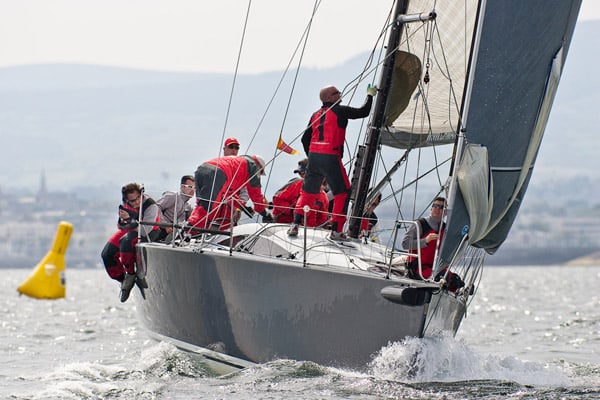
Anthony O'Leary (IRL)
David Lenz (GBR)
Peter O'Leary (IRL)
Ross Deasy (IRL)
Brian Lennon (IRL)
Stephen O'Sullivan (IRL)
Eoin Leahy (IRL)
Frederick Cudmore (IRL)
Simon Johnson (IRL)
Rory O'Sullivan (IRL)
Jimmy Houston (GBR)
Derek Moynan (IRL)
Tom Durcan (IRL)
Robert O'Leary (IRL)
Darragh O'Connor (IRL)
IRL39000 Marinerscove.ie David Dwyer (Mills 39)

Andy Beadsworth (GBR)
David Bolton (IRL)
Padraig Byrne (IRL)
Alan Curran (IRL)
David Dwyer (IRL)
Bernard Fitzpatrick (IRL)
Brian Heneghan (IRL)
David Love (IRL)
Tom Murphy (IRL)
Nicholas O'Leary (IRL)
Clive O'Shea (IRL)
Sandy Rimmington (IRL)
Chris Schirmer (GBR)
Don Wilson (IRL)
IRL36000 Roxy 6 Robert Davies (Corby 36)

Rob Davies (GBR)
Andrew Creighton (IRL)
Marty O'Leary (IRL)
Jim Hughes (IRL)
Paul Farries (GBR)
Nelson Moore (IRL)
Tom Whitburn (GBR)
Michael Liddy (IRL)
Aidan O'Connell (IRL)
Maurice O'Connell (IRL)
Team Management:
Barry Rose, Fintan Cairns, Denis Kiely, Mike Broughton and Norbert Reilly
- RORC
- Anthony O'Leary
- Norbert Reilly
- ICRA
- Eoin Leahy
- Maurice O'Connell
- Commodores Cup
- Fintan Cairns
- Peter O'Leary
- antix
- Mike Broughton
- roxy 6
- Mariners Cove
- David Lenz
- Ross Deasy
- Brian Lennon
- Stephen O'Sullivan
- Frederick Cudmore
- Simon Johnson
- Rory O'Sullivan
- Jimmy Houston
- Derek Moynan
- Tom Durcan
- Robert O'Leary
- Darragh O'Connor
- Andy Beadsworth
- David Bolton
- Padraig Byrne
- Alan Curran
- David Dwyer
- Bernard Fitzpatrick
- Brian Heneghan
- David Love
- Tom Murphy
- Nicholas O'Leary
- Clive O'Shea
- Sandy Rimmington
- Chris Schirmer
- Don Wilson
- Rob Davies
- Andrew Creighton
- Marty O'Leary
- Jim Hughes
- Paul Farries
- Nelson Moore
- Tom Whitburn
- Michael Liddy
- Aidan O'Connell
- Barry Rose
- Denis Kiely


























